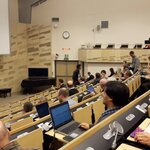Physics

After one quite frantic November, I emerged victorious two weeks ago from the delivery of a 78-pages, 49-thousand-word review titled "Hadron Collider Searches for Diboson Resonances". The article, which will be published in the prestigious "Progress in Particle and Nuclear Physics", an Elsevier journal with an impact factor above 11 (compare with Physics Letters B, IF=4.8, or Physical Review Letters, IF=8.5, to see why it's relevant), is currently in peer review, but that does not mean that I cannot make a short summary of its contents here."Dibosons" do not exist in a proper sense - the word…

It was nice to find John Duffield's review of my book "Anomaly! Collider Physics and the Quest for New Phenomena at Fermilab" in the Amazon site today. John, who is a reader and commenter of this blog, liked the book as he took it the way I wanted it to be taken - as an entertaining account of a 600-scientists endeavour which could manage to pass some complex physics explanations along the way. John's review is the third one on the Amazon site, and joins a dozen others overall, all but one of which were quite positive (at least the way I read them). Anyway, you can decide for yourself below,…

An experiment designed to study neutrinos at the Gran Sasso Laboratories in Italy is under attack by populistic media. Why should you care? Because it's a glaring example of the challenges we face in the XXI century in our attempt to foster the progress of the human race.What is a neutrino? Nothing - it's a particle as close to nothing as you can imagine. Almost massless, almost perfectly non-interacting, and yet incredibly mysterious and the key to the solution of many riddles in fundamental physics and cosmology. But it's really nothing you should worry about, or care about, if you want to…

Following the appearance of Kent Staley's review of my book "Anomaly!" in the November 2017 issue of Physics Today, the online site of the magazine offers, starting today, an interview with yours truly. I think the piece is quite readable and I encourage you to give it a look. Here I only quote a couple of passages for the laziest readers.
PT: What was the most surprising or challenging thing about working in a large collaboration like CDF?
DORIGO: Back in those years, CDF looked like a large collaboration, yet now CMS and ATLAS have an order of magnitude more collaborators. This…

Another quite positive review of my book "Anomaly! Collider Physics and the Quest for New Phenomena at Fermilab" (which these days is 40% off at the World Scientific site I am linking) has appeared on Physics Today this month. The piece is by Kent Staley, a philosopher of science who knows the matter more than about anybody who's not a particle physicist, as he himself wrote a quite insightful and engaging book on the road to the top quark discovery and the general issue of collaborative work in these HEP endeavours, "The Evidence for the Top Quark: Objectivity and Bias in Collaborative…

Writing a serious review of research in particle physics is a refreshing job - all the things that you already knew on that specific topic once sat on a fuzzy cloud somewhere in your brain, and now find their place in a tidily organized space, with clear interdependence among them. That's what I am experiencing as I progress with a 60-pageish thing on hadron collider searches for diboson resonances, which will appear sometime next year in a very high impact factor journal.One of the things that the review must cover is a theoretical overview of the models that the searches for these physics…

Today at CERN a workshop started on the physics of the High-Luminosity and High-Energy phases of Large Hadron Collider operations. This is a three-days event meant at preparing the ground for the decision on which, among several possible scenarios that have been pictured for the future of particle physics in Europe, will be the one on which the European Community will invest in the next few decades. The so-called "European Strategy for particle physics" will be decided in a couple of years, but getting the hard data on which to base that crucial decision is today's job. Some context
If…

Yesterday, October 20, was the international day of Statistics. I took inspiration from it to select a clip from chapter 7 of my book "Anomaly! Collider physics and the quest for new phenomena at Fermilab" which attempts to explain how physicists use the concept of statistical significance to give a quantitative meaning to their measurements of new effects. I hope you will enjoy it....
----
As we near the discussion of the discovery of the top quark, we need to make a digression to explain an important concept used by particle physicists to measure the level of surprise of an observation, i.e…

A Theory Of Everything, A One Inch Equation With Predictions That Agree With Observations and GR=QFT
The Theory of Everything may be a mathematically simple model which is rich in implications and more difficult in concepts than calculations. The model I have just published as a candidate theory of everything is just such a model. String theory on the other hand is simple in concept but difficult in calculations. The concept of my model is that we treat all energy the same way. This is a MASSIVE oversimplification. All the scientific details for any experts that have questions are in the latest paper and the references to it. This is an idea developed in…

Like many others, I listened to yesterday's (10/16/17) press release at the NSF without a special prior insight in the physics of neutron star mergers, or in the details of the measurements we can extract from the many observations that the detected event made possible. My knowledge of astrophysics is quite incomplete and piecemeal, so in some respects I could be considered a "layman" listening to a science outreach seminar.
Yet, of course, as a physicist I have a good basic understanding of the processes at the heart of the radiation emissions that took place two hundred million years ago…